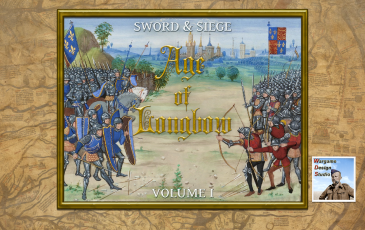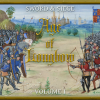003.ALB1_Boot Camp 3 - WDS Age of Longbow Volume I

 0 - 0 - 0
0 - 0 - 0

| Rating: | 0 (0) |
| Games Played: | 0 |
| SM: | 1 |
| Turns: | 15 |
| Type: | Stock |
| First Side: | Side_A (ALB1) |
| Second Side: | Side_B (ALB1) |
Boot Camp 3: Archers and Stakes
This scenario is designed to teach players how to fight a defensive action against 2:1 odds.
A small English force of mostly veteran troops is deployed between two woods and is comprised of dismounted men-at-arms flanked by archers. Some trenches and abatis help strengthen the position. There are some additional units of men-at-arms in the rear - one dismounted and currently in column formation and one mounted and concealed on the flank in dead ground out of sight of the enemy. Two units of "dragoon" cavalry, in this case mounted infantry armed with longbows and unable to shoot whilst mounted, cover the flanks. There are also two fixed units of low quality camp followers, which are best kept out of the fight as far as possible. Some English reinforcements may arrive mid-battle on the main road at the top map edge - their arrival could make a significant difference to the outcome of the fight, but unfortunately they may not arrive promptly.
The enemy forces include a mixture of cavalry, infantry and some guns and vary in quality from veteran to militia. The French cavalry is average to good quality and mostly heavy lancers, but includes several units of double-armed "archers" that can also fight dismounted. The French infantry are poor to average quality and include crossbowmen, archers - with inferior bows to the English - and militia spearmen. There is also a single unit of hand gunners, which have a short range, but are quite effective against armored opponents. The Scottish allied troops, which vary in quality, are all foot archers - many armed with longbows, so will be the most dangerous opponents in a fire-fight. The Italian mercenaries are high quality Milanese cavalry on barded horses, so these troops will suffer fewer casualties if shot at by archers.
The enemy move first and their cavalry are likely to advance rapidly towards the English defenders. On the first English turn, the archers need to deploy stakes to defend themselves adequately from the enemy cavalry and the men-at-arms should change from line into block formation, since stakes and block negates the melee benefit of charging cavalry. The English guns are ribaulds, which are short-range multi-barreled guns which will only be able to fire when the enemy get within a few hexes distance.
The outnumbered English should try to hold the line as long as they can, until the enemy outflank the position and should then fall back to the objectives, keeping the archers out of open ground when facing enemy cavalry, unless they have time to place more stakes.
Recommended Rules: [Default]
Note: Side A = French, Scottish and Milanese mercenaries, Side B = English
Primarily intended for play as the English side against the French / Scottish / Milanese A/I, but can be played from either side. If played Head-To-Head, it's recommended that the more experienced player takes the English side.
This scenario is designed to teach players how to fight a defensive action against 2:1 odds.
A small English force of mostly veteran troops is deployed between two woods and is comprised of dismounted men-at-arms flanked by archers. Some trenches and abatis help strengthen the position. There are some additional units of men-at-arms in the rear - one dismounted and currently in column formation and one mounted and concealed on the flank in dead ground out of sight of the enemy. Two units of "dragoon" cavalry, in this case mounted infantry armed with longbows and unable to shoot whilst mounted, cover the flanks. There are also two fixed units of low quality camp followers, which are best kept out of the fight as far as possible. Some English reinforcements may arrive mid-battle on the main road at the top map edge - their arrival could make a significant difference to the outcome of the fight, but unfortunately they may not arrive promptly.
The enemy forces include a mixture of cavalry, infantry and some guns and vary in quality from veteran to militia. The French cavalry is average to good quality and mostly heavy lancers, but includes several units of double-armed "archers" that can also fight dismounted. The French infantry are poor to average quality and include crossbowmen, archers - with inferior bows to the English - and militia spearmen. There is also a single unit of hand gunners, which have a short range, but are quite effective against armored opponents. The Scottish allied troops, which vary in quality, are all foot archers - many armed with longbows, so will be the most dangerous opponents in a fire-fight. The Italian mercenaries are high quality Milanese cavalry on barded horses, so these troops will suffer fewer casualties if shot at by archers.
The enemy move first and their cavalry are likely to advance rapidly towards the English defenders. On the first English turn, the archers need to deploy stakes to defend themselves adequately from the enemy cavalry and the men-at-arms should change from line into block formation, since stakes and block negates the melee benefit of charging cavalry. The English guns are ribaulds, which are short-range multi-barreled guns which will only be able to fire when the enemy get within a few hexes distance.
The outnumbered English should try to hold the line as long as they can, until the enemy outflank the position and should then fall back to the objectives, keeping the archers out of open ground when facing enemy cavalry, unless they have time to place more stakes.
Recommended Rules: [Default]
Note: Side A = French, Scottish and Milanese mercenaries, Side B = English
Primarily intended for play as the English side against the French / Scottish / Milanese A/I, but can be played from either side. If played Head-To-Head, it's recommended that the more experienced player takes the English side.





















